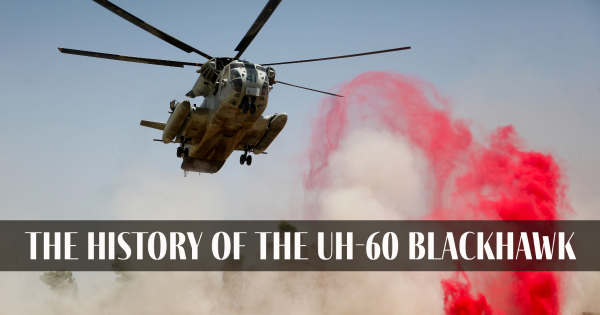Navigating Success: UH 60 Helicopter Maintenance Best Practices
Navigating Success: UH 60 Helicopter Maintenance Best Practices
Blog Article
Comprehending the Mechanics and Engineering Behind Uh 60 Helicopters
The UH-60 helicopter, typically known as the Black Hawk, stands as a pinnacle of modern-day rotorcraft innovation, symbolizing a blend of durable design and complex auto mechanics. As we peel off back the layers of the UH-60's design, a world of elaborate systems and meticulous design comes to light.
Background of UH-60 Helicopters
The history of UH-60 helicopters traces back to the late 1970s when the United States Army sought a versatile and sophisticated utility helicopter to change its aging fleet. In reaction to this demand, the Sikorsky Airplane Corporation established the UH-60 Black Hawk helicopter. Introduced in 1979, the UH-60 swiftly came to be a staple in military operations due to its impressive capacities.
The UH-60 was developed to excel in a range of goals, consisting of army transport, clinical emptying, digital war, and special procedures. Its ability to adapt to various roles made it a valuable property to the U.S. uh 60. Military and various other military forces worldwide
For many years, the UH-60 system has actually gone through numerous upgrades and variations to enhance its efficiency and keep speed with progressing objective requirements. These helicopters have seen considerable service in problems such as the Gulf Battle, Afghanistan, and Iraq, showcasing their dependability and adaptability in varied operational settings. The UH-60's rich background is a testament to its long-lasting heritage as a leading energy helicopter.

Engine and Power Solutions
Making use of cutting-edge propulsion technology, UH-60 helicopters are furnished with innovative engine and power systems to guarantee ideal efficiency and dependability in a variety of functional situations. The UH-60, generally known as the Black Hawk, is powered by 2 General Electric T700-GE-701D engines, each capable of supplying up to 1,940 shaft horse power. These turboshaft engines give the necessary thrust for the helicopter to bring out its missions properly, including army transportation, clinical discharge, and fight support.

Rotor System and Aerodynamics
How do the blades system and the rules of aerodynamics of UH-60 helicopters add to their operational efficiency and trip abilities? The rotor system of the UH-60 helicopter plays an important duty in giving lift and propulsion.
The rules of aerodynamics likewise play a key role in the efficiency of UH-60 helicopters. The structured fuselage and rotor blade layout decrease drag, allowing the helicopter to attain higher rates and much better fuel performance. The aerodynamic design of the UH-60 likewise adds to its capacity to operate in varied environmental problems, including high elevations and hot temperature levels.
Avionics and Flight Control Systems

In find more its elaborate control with the rotor system and the rules of aerodynamics of UH-60 helicopters, the avionics and flight control systems create an important network of innovations shaping the airplane's functional abilities. Avionics incorporate the electronic systems used for interaction, navigation, and keeping an eye on various airplane features. In the UH-60, these systems include digital screens, interaction radios, GPS navigating, climate radar, and autopilot systems. These avionics systems provide crucial info to the pilots, boosting situational awareness and making sure efficient and risk-free procedure of the helicopter.
The trip control systems of the UH-60 are accountable for translating the pilot's inputs right into the proper adjustments to the blades system, guaranteeing stable flight go and maneuverability. These systems are composed of hydraulic actuators, servos, and computer systems that interact to regulate the major and tail blades, as well as various other trip control surface areas. By specifically taking care of the helicopter's trip characteristics, these systems enable pilots to carry out a large range of objectives, from transportation and search-and-rescue to deal with procedures, with accuracy and self-confidence.
Function and Applications in Air Travel
The function and applications of avionics and flight control systems in air travel are indispensable to guaranteeing the safe and efficient procedure of airplane, consisting of UH-60 helicopters. Avionics systems in UH-60 helicopters incorporate a variety of electronic systems that aid in navigation, interaction, surveillance, and controlling numerous airplane functions. These systems include electronic display screens, auto-pilot systems, interaction radios, GPS navigation tools, and climate radar. Trip control systems play a critical duty in steering the helicopter in the air, maintaining security, and making sure accurate movements. The fly-by-wire technology made use of in contemporary UH-60 helicopters equates pilot inputs into digital signals, which are then interpreted by the trip control computer systems to adjust the airplane's control surfaces. In addition, these systems include security features such as auto-pilot modes, surface understanding advising systems, and security augmentation systems to enhance the general safety and functional capabilities of the UH-60 helicopters in different missions, consisting of troop transportation, medical emptying, search Resources and rescue, and aerial firefighting.
Conclusion
In verdict, the UH-60 helicopter is a versatile aircraft with a rich background and advanced design. Its engine and power systems, rotor system, aerodynamics, avionics, and trip control systems all work together to make it a effective and reputable maker.
In its detailed control with the blades system and the rules of aerodynamics of UH-60 helicopters, the avionics and flight control systems develop an essential network of modern technologies forming the airplane's operational capacities.The trip control systems of the UH-60 are liable for converting the pilot's inputs right into the proper modifications to the blades system, making certain stable flight and ability to move. Avionics systems in UH-60 helicopters include a range of electronic systems that help in navigation, communication, surveillance, and managing different aircraft features. Furthermore, these systems integrate safety functions such as autopilot settings, terrain awareness advising systems, and security enhancement systems to improve the overall safety and functional capabilities of the UH-60 helicopters in numerous objectives, consisting of troop transportation, clinical evacuation, search and rescue, and airborne firefighting.
Its engine and power systems, rotor system, the rules of aerodynamics, avionics, and trip control systems all function together to make it a efficient and trusted maker.
Report this page